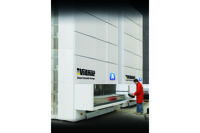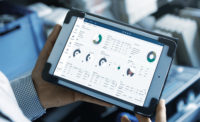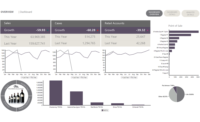The U.S. Roadmap for Material Handling & Logistics, Charlotte, N.C., predicts that there will be 1.4 million new jobs created in the supply chain and logistics sector over the next three years, says Andy Drozinski, managing executive, solutions and product groups for MHI, the Charlotte, N.C.-based producer of the MODEX tradeshow.
“And to fill those jobs, the supply chain industry must find ways to attract demographics that historically haven’t comprised a significant part of its workforce,” he adds.
In fact, manual processes are a thing of the past for all aspects of the supply chain, says Staci Cretu, marketing communications manager for Westfalia Technologies, Inc., York, Pa.
“These once manual tasks are now being replaced with automation,” she adds. “For manufacturers and distributors, this means automating material handling processes to improve their current processes and systems.”
Discover how the human’s role is transforming thanks to today’s highly complex automated storage and retrieval systems (AS/RS).
Innovation for the future
Big data, cloud-based, mobile robotics, wearable technology, Internet of Things—all trends driving innovation in AS/RS.
To meet such trends, Schaefer Systems International, Inc., Charlotte, N.C., for example, launched the Exyz crane, ideal for different, serial-produced basic elements, creating a comprehensive pool for customer-specific, mounted-end devices.
Schaefer Systems also developed the SCHAEFER Lift&Run, which consists of a transfer carriage with lifting device for the SCHAEFER Orbiter pallet shuttle system to run on two rails without the need of upper guiding rails. Powered by Power Cap technology, the Orbiter is said to be the only pallet shuttle system in the market that does not require batteries to operate.
Meanwhile, Murata Machinery USA Inc., Charlotte, N.C., introduced FX Quad, a mini-load crane that can move four cases at a time with double-deep racking, according to Victor Hoerst, sales account manager. The FX Quad is compatible with dense case storage such as totes/case loading, and can be combined with a pallet AS/RS to provide residual case management with high-density storage.
Last year, Kardex Remstar, LLC, Westbrook, Maine, redesigned the Megamat RS 350 to be an automated, computer-controlled vertical carousel that operates as a central inventory storage carousel. The Megamat RS 350 features a self-tensioning drive system that eliminates the need for frequent service adjustments when the unit is subjected to frequent loading and unloading, says Allan Archer, government sales specialist. With its compact and sturdy equipment features, the Megamat vertical carousel requires a small footprint, utilizes the entire available ceiling height and can be installed up to 32 feet high, allowing access from a second floor.
For its part, Hänel Storage Systems, Pittsburgh, Pa., engineered the Hänel ColdCell, a vertical carousel designed to evenly distribute cooling air throughout the unit, thus maintaining a target temperature with minimal energy consumption.
“Carousels and vertical lift modules are being implemented in applications that are considered mission critical and must deliver continual accessibility to the goods stored within,” says Brian Cohen, chief executive. “Our design strategy is to include redundant components for the most vulnerable parts of the units.”
Dematic North America, Grand Rapids, Mich., introduced a new version of RapidStore UL1400, an AS/RS that automates conventional pallet storage, includes performance optimizing software and supports a wider variety of applications, including freezer/cooler environments.
“RapidStore UL1400 has effectively combined traditional AS/RS with conventional post-and-beam rack and offers a low first shelf height (8 inches) to maximize warehouse space. The rotating fork moves vertically and pivots in order to access pallet loads on either side of the aisle. The rotating fork can pick or deposit pallet loads at either end of the aisle, including interface to push back rack and empty pallet stackers,” says Ken Ruehrdanz, manager, distribution systems market. “Dematic iQ software manages the activity, inventory and material flow with a focus on optimization and accuracy. Advanced pallet put-away and retrieval logic dynamically adjusts/prioritizes work flow; this results in smarter logistics management and timely execution.”
The Vectura freezer pick solution from Swisslog North America, Newport News, Va., incorporates pallet AS/RS, case AS/RS and robotic palletizing and de-palletizing to provide a fully automatic receipt-to-ready solution for shipping chilled and frozen products.
Swisslog’s new CycloneCarrier is a faster, more agile AS/RS that incorporates direct carton handling technology, thus removing the need for another storage medium, such as totes, bins and trays.
And, its automated item pick solution is designed for repeated single-item picks to fulfill fast delivery. Plus, this automated item pick workstation is built as a “plug-and-play” system, meaning it’s interchangeable with workers to provide flexibility, says Brad Moore, director of business development.
The importance of upgrading a modern warehouse
Modularity and scalability are keys to success for the modern warehouse, Moore adds.
“The business needs are changing so rapidly that most companies cannot forecast their business needs for the long haul, therefore a solution like click and pick is perfect,” he says.
To keep up with the ever-changing modernization of today’s warehouses, AS/RS technologies need to modernize as well.
“Traditionally, an AS/RS includes storage racking, the crane itself, a rail for the crane to traverse the aisle and the load handler that interacts with the load,” says Nathan Busch, associate consulting engineer for Bastian Solutions, Indianapolis, Ind. “But, Bastian Solutions is also integrating with some other goods-to-person technologies that are paving the way for operations of the future.”
Bastian Solutions, for instance, maintains a robotics division in St. Louis, Mo., that custom builds its own robotic systems and controls and integrates its solutions with automated guided vehicles and warehouse management software.
“Automation and robotics allow for more standardization, more flexibility, better inventory accuracy, better product protection and loss prevention, etc.,” Busch adds. “Automation and robotics can also handle loads and environments that may not be suitable for manual operations, such as cooler or freezer environments and heavy or awkward loads.”
Machine learning has also become a large part of today’s automated storage solutions.
“Monitoring operating data real time allows for our maintenance and operation team to proactively seek out future problems and have our technicians be better prepared when they make service calls,” says Mark McKeever, vice president, business development for Sapient Automation, Hatfield, Pa.
Likewise, a modern operation needs intelligent components such as distance and ranging sensors that provide positional data and photoelectric sensors, according to John Ashodian, logistics automation marketing manager for Minneapolis-based SICK, Inc.
“Reporting operational status, providing measurement and condition data and supplying predictive analysis in a wide range of environments makes these systems smarter and more efficient,” he adds.
Murata Machinery, on the other hand, utilizes wearable technology with its service team to transmit real-time video footage of what is happening on the floor to a more experienced technician or to the company’s support headquarters.
Generally speaking, today’s AS/RS need to be connected, adds Cynthia Hamann, marketing manager for Retrotech, West Henrietta, N.Y.
“For instance, from one well-connected AS/RS, a plant manager may be able to see in real time the overall productivity of his warehouse from cost-per-touch, cost-per-pallet movement, inventory on hand, order fulfillment rate, and at the same time, given the same data set, the maintenance manager is able to see and ensure the overall health of the components that make up the AS/RS,” she says.
Plus, it’s getting harder to find people to do the work, adds John Clark, marketing and new business development manager for Viastore, Grand Rapids, Mich.
“When you add in doing work in the harsh conditions of a frozen warehouse, where the difference between the freezer and the outside can easily be over 100 degrees, not many people want to work in that environment,” he adds.
For more on these and other AS/RS, go to bit.ly/1RFHRSs.














